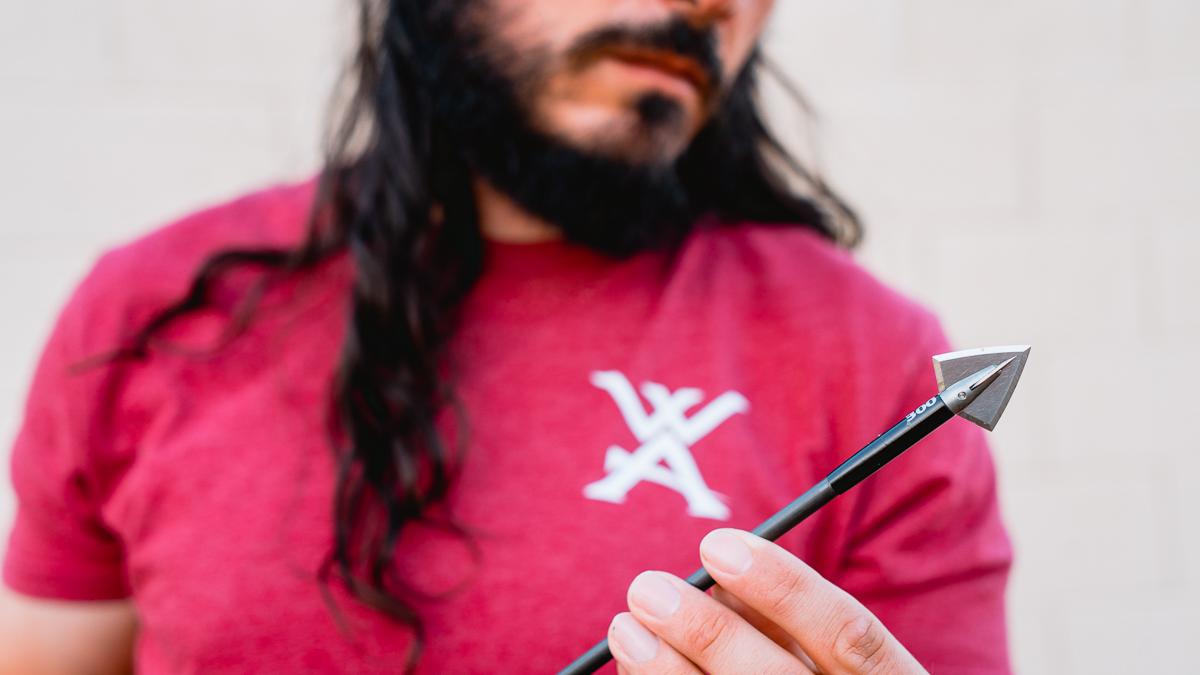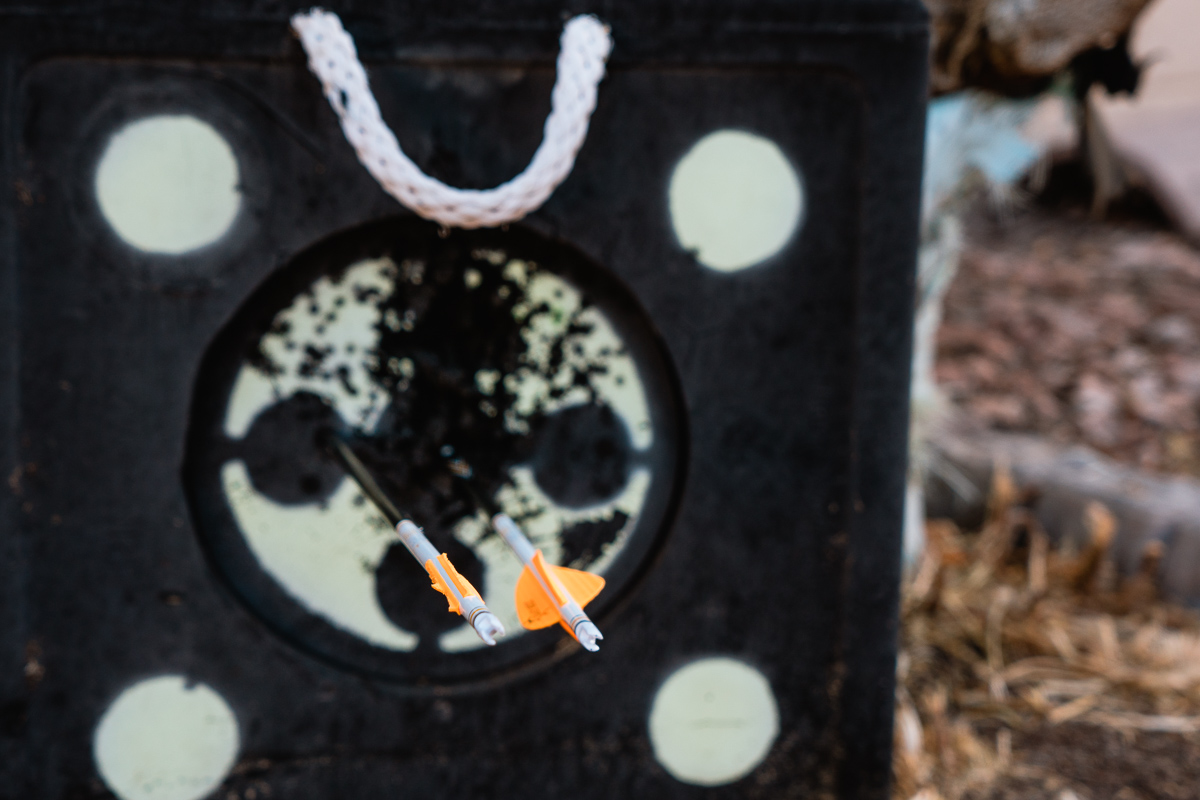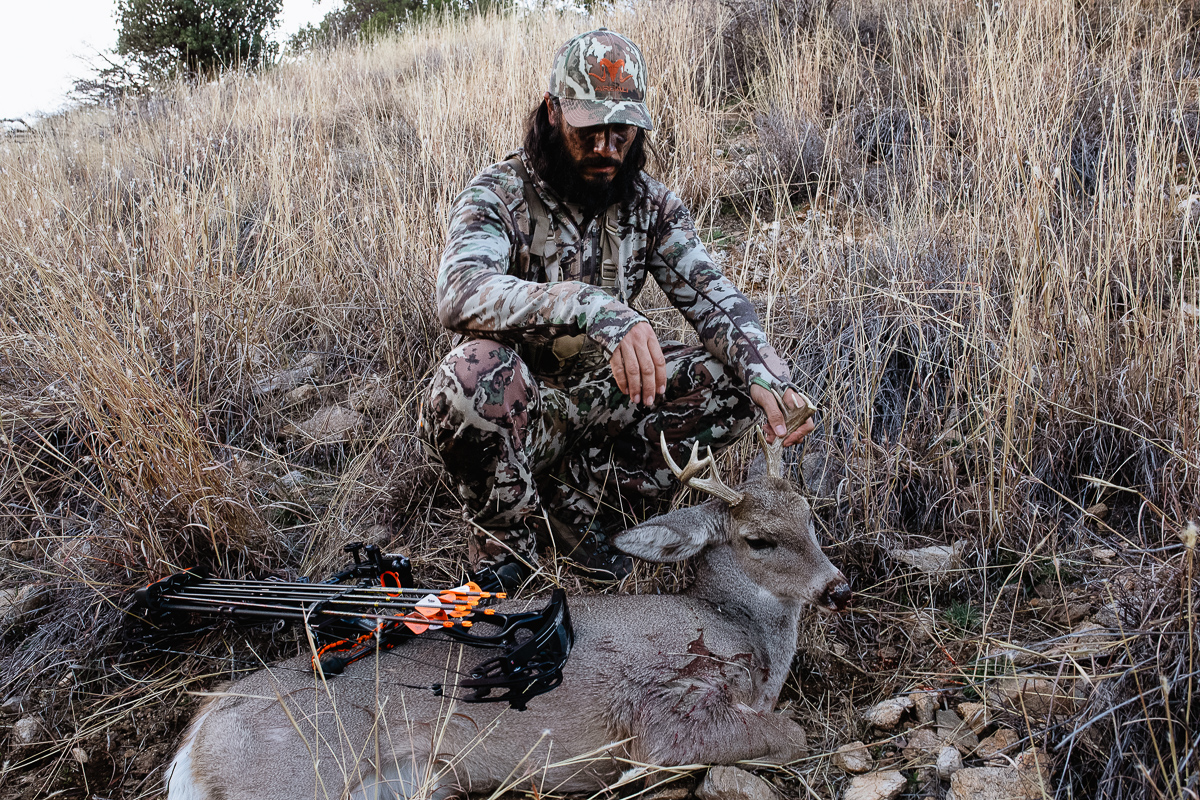
Broadhead Tuning 101: A How to Guide to Bare Shaft Tune Any Bow
By Josh Kirchner
In our piece on common causes of bad broadhead flight, we discussed the most likely culprits of bad broadhead flight. In this piece, we are going to walk you through the actual process of broadhead tuning, including our preferred method of broadhead tuning, bare shaft tuning. A step by step guide to getting your broadheads flying right with your field points.
Bare shaft tuning is where one shoots arrows stripped of fletchings in order to magnify any minor kinks in arrow flight which are caused by your bow. Without fletchings, the arrow's flight wont be corrected as it flies down range by the fletchings. Thus, any minor imperfection in your bow (or your shooting form) will be magnified with a bare shaft arrow. And, remember, broadheads are like fletchings on the front of an arrow. If that arrow isn't coming out of the bow perfectly straight, the broadhead will steer the arrow off course.
Before we dive into the deep end on this, I just want to acknowledge there are many methods for tuning broadheads. French tuning, walk-back tuning, and other methods can yield the same end result: broadheads and field points in the bullseye. Our goal here is to take it a bit further. We don't want to just give you great broadhead flight with your broadhead of choice. We want to get your bow so dialed that you'll have the ability to shoot ANY broadhead you want without fail.
After this whole bare shaft tuning process is done, you should be able to screw on a broadhead and be smashing the X.
Why Bare Shaft Tune
Having done other tuning methods, it is our humble opinion that bare shaft tuning is the quickest, easiest and most efficient process for dialing in your bow. Since your bare shafts will fly similarly to an arrow with a broadhead, bare shaft tuning allows shooters the ability to tune a bow without the cost and frustration that can come from tuning using broadheads and potentially missing the target and losing both an arrow and a broadhead.
Not to mention, if you can get bare shafts to group tightly at 30, 40 or even 50 yards, it will make you a better shooter.
First Thing is First
In order for bare shaft tuning to work properly, there are a few boxes that need to be checked. The first is making sure that your bow and setup is in working order. Are your cams in time? Are your sight axis' leveled? Have you already paper tuned your bow? Are you shooting a properly spined arrow? If you haven't already read our previous article on 5 common causes of bad broadhead flight, be sure to read it to understand why it is imperative to make sure you have walked through the appropriate steps before you attempt to tune broadheads. If your cams aren't in time or your arrows aren't spined properly, you will chase your tail all day long and not be able to shoot consistent groups with broadheads.
Along with the overall build of the bow we want a basic tune on it, so we know the arrows are flying somewhat straight to start. Paper tuning will get you close to where you need to be. Think of it like bore sighting a rifle. You'll surely be headed in the right direction, but it probably won't put you in the X. This can either be done right at home by building your own paper tuning setup or you could also take the bow into a shop. Whatever works best for you. Bottom line, make it happen.
One more, important note. Any minor imperfection in your shot form can cause a bare shaft to fly wild. Punching the trigger, torquing the bow, or any other imperfection will be magnified 10x in the flight of your arrow. The ability to use bare shaft tuning to tune your boadheads assumes the shooter has decent form.
1. Shoot for Groups
Once you know that your bow is sound and working properly, it's time to get this shindig started. I want to point out both fletched and bare shafts will be shot with field points here. The first thing you are going to want to do is to get your bow sighted in with fletched arrows at 20 yards. You need to be grouping with those fletched arrows before moving on to the bare shafts. This is vital. After you've gotten to the point of abusing the bullseye on your target, now it's time to grab a bare shaft.
Leave those fletched arrows in the target and shoot the bare shaft towards the same mark. Shoot enough arrows to get a good sense of any patterns in where your bare shafts are consistently hitting relative to your field points. As you shoot, remember that it isn't abnormal to get an arrow to fly 6 inches from where you are aiming, particularly if your form for that shot wasn't perfect. Look for patterns in your shots, and don't make changes based on a single "flyer".
Take note of where your bare shaft arrows are grouping in relation to your fletched arrows. The difference between the two will tell you what you need to do next.
2. Adjust Your Rest
What you do next in the process is going to be a reflection of where that bare shaft hits in relation to your fletched arrows. You will move your rest to get your bare shafts and fletched arrows to group. If bare shafts are hitting with the fletched arrows at 20 yards, proceed to step #3 below.
Bare Shaft Hitting Left or Right of Field Points
One of the most common mistakes with left/right misses in this process is folks think that they need to move their sight left or right. That couldn't be farther from the truth. This doesn't fix the problem. It merely puts a poorly built bandaid on it. In order to truly fix the issue, the arrow rest is what you want to turn to. And in bare shaft tuning, you will use your rest to adjust the flight of your arrow. Remember with bare shaft tuning that you should ALWAYS be moving your rest in the direction of your field point TOWARDS your bare shaft. In other words, always chase the bare shaft when moving your rest.
If that bare shaft is hitting left of the fletched, move the arrow rest VERY SLIGHTLY to the left. Like 1/32 or 1/64 of an inch. If the bare shaft hits right, then move your rest to the right. Shoot after each adjustment to note any progress. You should see that bare shaft start to make its way in with the fletched arrows after one or two tweaks to the rest. After this, you'll need to make a windage adjustment on your bow sight to bring those arrows back into the bullseye.
In the event that the impact point of the bare shaft doesn't change after you have moved your rest, or doesn't change enough, you might have an arrow spine issue. Hits to the right are an indicator of an under spined arrow. This would mean that your arrow has too much flex in it for your set up and isn't recovering quick enough in flight. The solution here would be a stiffer spined arrow(lower number. Example being going from a 400 to a 300). Left hits are, you guessed it, an indicator of an over spined arrow. So the arrow doesn't have enough flex in it and is over correcting itself in flight. The solution being a less stiff spined arrow(higher number. Example being going from a 300 to a 400).
Bare Shaft Hitting High or Low
If your bare shaft happens to be hitting high or low from the fletched arrows there is a slightly different approach with some other variables at play. The easiest thing to do here is to adjust the arrow rest either up or down. Move the arrow rest in the opposite direction of that bare shaft. So, if the bare shaft hits high, move the rest down and the same if it hits low, move the rest up. Remember, make minute adjustments.
There is something else that you want to watch out for, and it's called nock pinch. This is where either side of the D-Loop pinches down on the nock at full draw. It's something that is easily fixed by adding in nocking points within the inside of the D-Loop. A simple serving on the top and bottom of where your nock sits on the string will keep the D-Loop from pinching down on the nock at full draw. Nock pinch can absolutely cause high/low misses.
3. Move Back
If you are bare shaft tuning for the first time, after you have shot at 20 yards and adjusted your rest, go back to 30 yards and repeat the process in steps #1 and #2. Remember, minor inconsistencies will be brought to light without the aid of those fletchings, and the further back you shoot, the bigger the magnification.
Move your rest as outlined in step #2 above in order to bring your bare shafted and fletched arrows together. Once you do that, you will need to make a windage adjustment again on your bow to bring your arrows back to the bulls eye.
4. Move Back Again (Optional)
This step is for the anal retentives. At this point, if you are getting tight groups with fletched and unfletched arrows at 30 yards, your rest is likely where it needs to be. But shooting at 40 yards can really tell you if there is a minor imperfection in the positioning of your rest.
You will repeat the same steps in steps #1 and #2 at this distance, focusing on good form. At this distance, arrows grouping 8 inches left or right can be resolved with a 1/64 of an inch adjustment.
5. Put on a Broadhead
Once your bare shafts and field points are grouping, and you have moved your sight to compensate for any movements in your rest, now it is time to shoot a broadhead to verify your tune. If you have done steps #1-4 correctly, your broadheads should shoot like a laser. If your broadheads do not group with your field points at this point in time, there is very likely something else going on with your bow that needs to be addressed like your cam timing, arrow spine, or nock point.
Why Go Through All of This?
The average bowhunter might be thinking something along the lines of "why go through all of this? Why can't I just paper tune my bow and adjust my sight to the broadheads I want to shoot?" By all means, if that's what you want to do, then have at it. With that being said, to answer the question, these little fine tuning adjustments make a big difference in the field. Things aren't always roses and apple pie out in the hills. That perfect setup that you shoot in your backyard with perfect stance at exactly 20 yards, flat across the yard is not what you will encounter come hunt time. It's going to look something more like shooting at a steep downhill angle, standing on uneven terrain, with the wind blowing and your nerves soaring. These things have an influence on our shot and they bring us below that 100% we are used to shooting at in the backyard.
For that reason, having that arrow coming out as straight as possible, will help alleviate any inconsistencies you might put on the bow in the moment of truth. Bare shaft tuning will get you there and give an unparalleled level of confidence in your bow. Plus, because you'll be able to shoot any broadhead you want, you're saving both time and money trying to find the perfect broadhead.
Bare shaft tuning is definitely a type of process that requires consistency in form and technique on the shooter's part. For that reason, it probably isn't the best thing to do for a beginner. If just starting out bowhunting, paper tuning with field points and throwing on a mechanical or low profile fixed blade should do just fine. For those looking to take it to the next level though, this is a killer way to get max performance out of your arrow in the field. Your freezer will thank you and you will thank your freezer.
If you have any questions on bare shaft tuning, leave them in the comments below.


